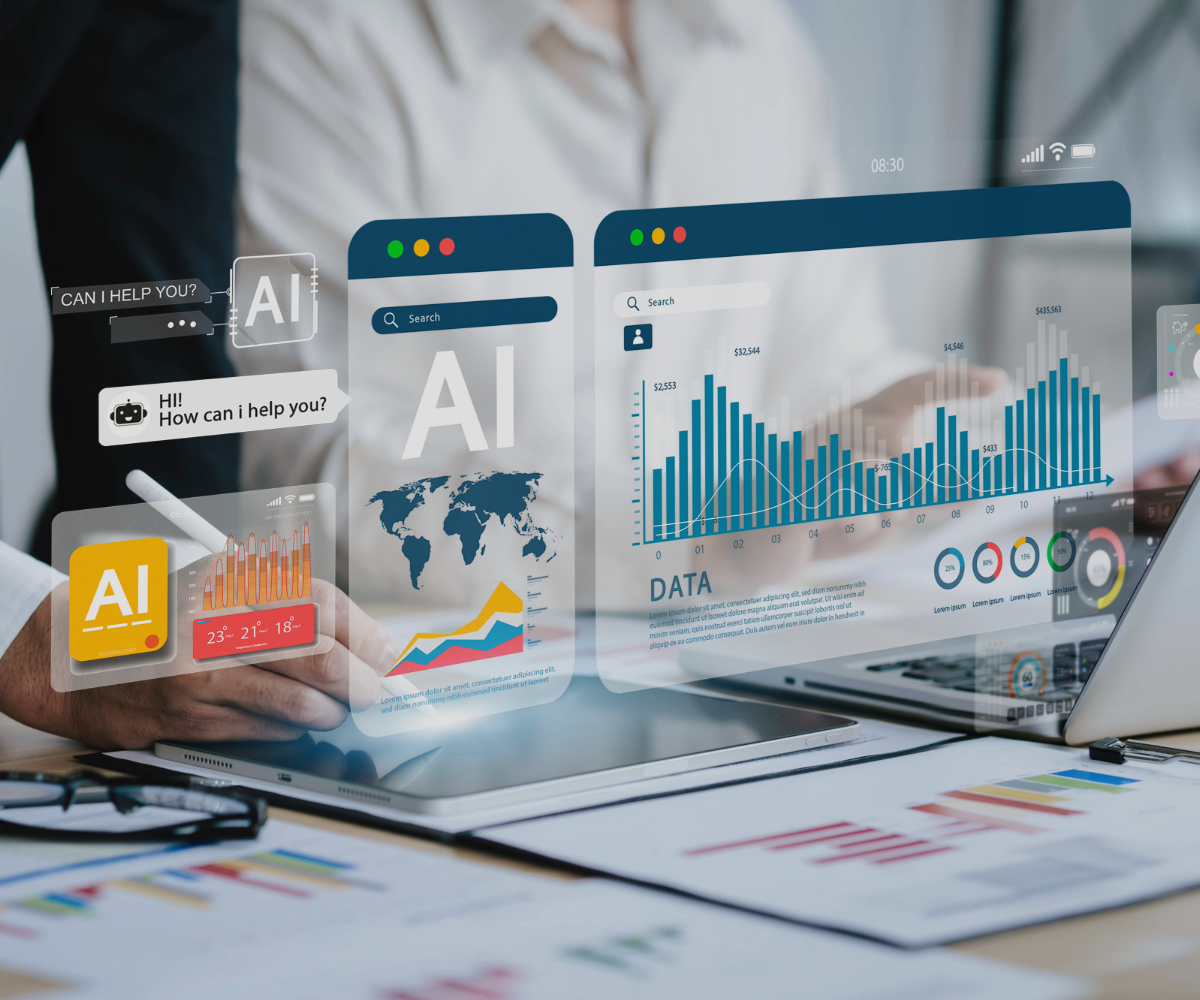The start of 2024 has been a rollercoaster of events in the marketing world. From social media outages to new platform updates like Google’s core algorithm changes. Q1 has been action-packed and has provided insights into marketing for 2024, especially the evolution of AI in marketing, where it’s at, and where it may be headed.
As AI continues to revolutionize the marketing landscape, marketers must stay updated on the latest trends and developments. AI tools like Chat GPT, Gemini, and Bard are making content creation easier for marketers by helping them brainstorm ideas, gather information, and draft content. In visuals and designs, the topic of generative AI imagery has been at the forefront. These trends have sparked discussions on how AI will change the marketing landscape for 2024 and beyond.
So let’s do a quick review of how AI has impacted the marketing landscape in Quarter 1 of 2024.
AI in Design: The Rise of Generative Fill
Generative Fill (a.k.a. Generative AI), the topic creating waves for a lot of designers and businesses, is built on the same foundation model as Chat GPT. From photo editing to ideation, Generative Fill streamlines the design process and sparks creativity. If you are not familiar, it allows designers to describe what they would like to create and generates a visual piece that matches the description and constraints that the designer had outlined.
It is an excellent resource for photo editing and compositing, where instead of taking hours of hand retouching an image from scratch, designers can now tell the AI what to do. The AI will generate 3 options (or more, if requested) and the designer can then choose the result closest to their needs. For example, at KEEN we might give a generative AI a text prompt and see what it comes up with to help spark new ideas for our team and create a starting ground for some projects.
However, it’s important to note that while AI in design offers immense potential, it’s not without its flaws. It will sometimes produce some spooky and melty-looking visuals and is often inconsistent with following directions. Check out this example below:
We wanted to use Generative Fill to make a small edit to an image. The simple prompt asked for the AI to change the text colour without modifying the text itself.
The results were not close to what we requested, and the AI removed the text and replaced it with a new visual:
We also used generative AI to create some graphic ideas with the prompt “Make us festive” and supplied our logo. The results were, to put it simply, not to KEEN’s traditional standards:
AI in design has existed for a while, although it has been getting more buzz the past few years. With Adobe’s Photoshop, it has introduced a lot of “new” AI-powered tools, but they’re just better iterations of tools they’ve always had, like the healing tool and background removal, object selection, etc. With the new generative AI Fill, it is still a long way to go in substituting design capabilities and our approach is to test and challenge it to see its evolution in the marketing landscape.
How Does AI Weigh Up In Content Marketing and SEO
On the Google side, there has been significant changes in Q1 with their core algorithm updates including targeting against fully AI-generated content.
Key Highlights From Google’s March Core Algorithm Update:
Reducing low quality content by 40%
- The core algorithm update, Google states, will help Google evaluate “webpages (that) are unhelpful, have a poor user experience or feel like they were created for search engines instead of people.”
Reduce spam content on search results
- Google states: “our ranking systems keep many types of low-quality content from ranking highly on Search”
Penalizing low-quality content produced at scale
- Google is taking a heavy stance on cracking down on low-quality or unoriginal content produced by AI or humans or a combination of both.
- Google states: “This will allow us to take action on more types of content with little to no value created at scale, like pages that pretend to have answers to popular searches but fail to deliver helpful content.”
Clampdown on site reputation and expired domain abuse
- Google is discouraging websites that use third-party content produced primarily for ranking purposes and websites that buy an expired domain and repurpose it to boost their own website content.
In short, Google is not penalizing content and creators using AI but content that has no added value to the end user – this means content must have substance beyond the obvious and carry authenticity. In other words, while AI-generated content can be valuable when supplemented with human expertise, Google aims to prioritize content that offers genuine value to users.
Let’s “EEAT” Quality Content
A format to drive quality and good content that has been verified by Google and is buzzing within the content and SEO community is the EEAT format. This shift underscores the importance of adhering to the EEAT format in creating high-quality content that resonates with both audiences and search engines. EEAT stands for:
Experience: Have relevant examples to complement the point of the content
Expertise: Establishing authority by demonstrating knowledge and thoughtfulness in the subject
Authoritativeness: Cite credible sources to support claims, especially if it is uncommon or contentious
Trustworthiness: Maintaining a professional tone and provide actionable advice, delivering authenticity to your audience
Google is pushing towards quality over quantity, which means the websites that are being penalized are ones that have content fully generated by AI. The issue with fully generated AI content is that it is repetitive to others that also use AI to generate the same content leading to low quality content as there is no uniqueness. Another big factor is the Experience (from EEAT), without providing relevant examples to support the content it eliminates opportunities to showcase originality – AI does not have real first-hand examples, only humans do.
Using AI is still viable for marketers in 2024 to deliver quality content. However, the emphasis cannot be placed on relying on AI to generate content, but to use AI to assist in enhancing and polishing content while requiring the marketer to deliver the unique human aspects like EEAT to drive the content.
Beyond AI In Marketing, Social Media Outages Still Exist In 2024
Lastly, a significant event in Q1 that struck waves across marketers and users from most industries is the sudden outage of major social media platforms with Meta (Instagram, Messenger, Threads, WhatsApp, and Facebook) down on March 5th and LinkedIn on March 6th. Not AI related, but a point to be made that all businesses should have alternative mediums and distribution channels to engage with your community.
Diversify Your Marketing Strategy
These outages are a reminder to not put all your eggs in one basket and to diversify different opportunities. Opportunities like building a customer list with a proper CRM system, utilizing email/SMS marketing to keep in touch with customers, and having a website so customers can still find you. As social media continues to be at the forefront of marketing, it is still important to diversify your marketing efforts in other mediums.
Final AI Take: Great But Do Not Rely On It
Whether you’re a marketer or business that is using AI or not, it will continue to be at the forefront of enhancing our quality of work and creativity. AI in Q1 of 2024 is great but not perfect and we still need to be wary of what it delivers to us. Similar to the precaution of thoroughly checking mirrors and surroundings before reversing a car, we must exercise similar diligence with AI outputs, rather than solely relying on its capabilities.
What’s Next?
We look forward to evaluating the marketing landscape in Q2 and positive changes to come towards higher quality content and the continued evolutions of AI in marketing. Stay tuned to our socials (@keencreative) and be sure to bookmark our website to easily access our next round up of marketing trends and changes of Q2 in July.
Looking for some marketing help? Let’s move your brand forward by visiting our Services page and contact us to get started today!



